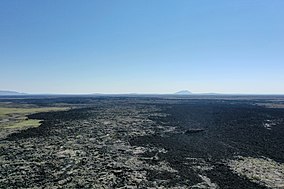
Back Craters of the Moon National Monument CEB Craters of the Moon National Monument German Monument national et réserve nationale Craters of the Moon French Monumento e riserva nazionale Craters of the Moon Italian Gunung Berapi Medan Lava Wapi Malay Craters of the Moon National Monument and Preserve Polish Лунные Кратеры Russian Craters of the Moon nationalmonument Swedish Національний парк «Місячні кратери» Ukrainian Oy kraterlari Uzbek
| Craters of the Moon National Monument and Preserve | |
|---|---|
IUCN category V (protected landscape/seascape) | |
 | |
| Location | South Central Idaho, United States |
| Nearest city | Arco (east) Carey (west) |
| Coordinates | 43°27′42″N 113°33′46″W / 43.46167°N 113.56271°W |
| Area | 753,000 acres (3,050 km2)[1] |
| Established | Monument: May 2, 1924, Preserve: August 21, 2002 |
| Visitors | 250,872 (in 2020)[2] |
| Governing body | National Park Service and Bureau of Land Management |
| Website | Craters of the Moon National Monument and Preserve |
Craters of the Moon National Monument and Preserve is a U.S. national monument and national preserve in the Snake River Plain in central Idaho. It is along US 20 (concurrent with US 93 and US 26), between the small towns of Arco and Carey, at an average elevation of 5,900 feet (1,800 m) above sea level.
The Monument was established on May 2, 1924.[3] In November 2000, a presidential proclamation by President Clinton greatly expanded the Monument area. The 410,000-acre National Park Service portions of the expanded Monument were designated as Craters of the Moon National Preserve in August 2002.[1] It spreads across Blaine, Butte, Lincoln, Minidoka, and Power counties. The area is managed cooperatively by the National Park Service and the Bureau of Land Management (BLM).[4]
The Monument and Preserve encompass three major lava fields and about 400 square miles (1,000 km2) of sagebrush steppe grasslands to cover a total area of 1,117 square miles (2,893 km2). The Monument alone covers 343,000 acres (139,000 ha).[5] All three lava fields lie along the Great Rift of Idaho, with some of the best examples of open rift cracks in the world, including the deepest known on Earth at 800 feet (240 m). There are excellent examples of almost every variety of basaltic lava, as well as tree molds (cavities left by lava-incinerated trees), lava tubes (a type of cave), and many other volcanic features.[6]
- ^ a b Record of Decision – FEIS GMP Archived 2020-11-11 at the Wayback Machine for Craters of the Moon NM and Preserve
- ^ Cite error: The named reference
visitswas invoked but never defined (see the help page). - ^ NPS 1991, p. 7.
- ^ Cite error: The named reference
NPS Managementwas invoked but never defined (see the help page). - ^ Cite error: The named reference
areawas invoked but never defined (see the help page). - ^ Louter 1992.

